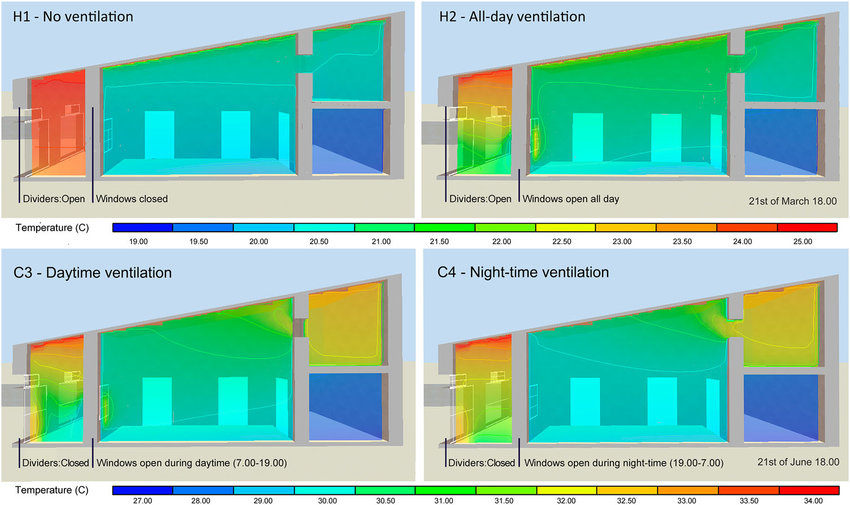Temperature plays a crucial role in architectural design, influencing both the functionality and comfort of indoor spaces. Understanding the patterns of temperature fluctuations is essential for optimizing energy use, ensuring thermal comfort, and enhancing the overall sustainability of a building. The architectural temperature profile provides a visual representation of how temperature varies in a specific location, both daily and seasonally. This analysis allows architects, engineers, and builders to create environments that respond effectively to changing temperatures, improving the well-being of occupants while reducing environmental impacts. This article explores the significance of seasonal and daily temperature variations in architecture and how this knowledge shapes building design.
The Importance of Temperature in Architecture
Temperature has a direct impact on human comfort, energy consumption, and building performance. In climates where extreme temperatures are common, the design of a building must account for thermal insulation, natural ventilation, and heating/cooling systems. Additionally, architectural temperature diagram affects materials used in construction, as different materials expand and contract with heat, impacting structural integrity. A well-designed temperature profile allows for better control of indoor climate conditions, reducing reliance on artificial heating and cooling, and ultimately contributing to energy efficiency.
Seasonal Temperature Variations
Seasonal variations in temperature are one of the most significant factors influencing a building’s design and performance. In regions with distinct seasons, temperatures can range dramatically between summer and winter, requiring buildings to adapt to both extremes. Seasonal temperature changes affect heating and cooling needs, daylight exposure, and even the moisture levels in the building, which can impact structural health.
Winter Season: During the colder months, the external temperature drops significantly, requiring buildings to maintain a warm indoor environment. Proper insulation, thermal mass (the ability of materials to absorb and store heat), and efficient heating systems become essential during this period. A building’s design should prevent heat loss and minimize the need for excessive heating by incorporating passive solar heating techniques, such as orienting the building to capture sunlight, or using materials that store heat during the day and release it at night.
Summer Season: Conversely, summer brings warmer temperatures, requiring buildings to stay cool without relying too heavily on air conditioning. A good architectural temperature profile will help designers incorporate shading devices, such as overhangs, louvers, or green roofs, that can block direct sunlight while still allowing natural light to filter in. Ventilation systems should be designed to allow cool air to circulate, and the use of light-colored or reflective materials on the building’s exterior can reduce heat absorption. Additionally, smart building technologies such as automated blinds or windows that adjust based on temperature can help maintain optimal indoor conditions.
Daily Temperature Variations
In addition to seasonal fluctuations, daily temperature variations significantly impact building design, especially in climates where the difference between day and night temperatures is pronounced. A typical day sees temperature shifts from the cooler morning hours to the hotter midday and back to cooler temperatures at night. These variations influence energy consumption patterns, as buildings must transition from heating to cooling and back again, often multiple times in a single day.
Morning and Night: In many regions, early mornings and late evenings bring lower temperatures, which means the building can often maintain comfortable indoor conditions without additional heating. By taking advantage of the cooler temperatures, buildings can minimize the need for mechanical cooling or heating. Smart design choices like well-placed windows, natural ventilation, and thick walls (for thermal mass) help maintain stable temperatures during these hours.
Midday: The hottest part of the day typically requires the building to provide cooling. This is when the need for energy-intensive cooling systems is at its peak. However, building designs that incorporate shading, passive cooling, and insulation strategies can reduce the reliance on mechanical systems, providing more sustainable solutions to controlling temperature. The use of high-efficiency HVAC (Heating, Ventilation, and Air Conditioning) systems also plays a crucial role in maintaining comfort during peak temperatures, without excessive energy use.
Tools for Analyzing Temperature Variations
Architects and engineers use several tools and methods to analyze and visualize temperature variations within a building or across a site. These tools help in creating a building’s temperature profile and understanding how different environmental factors contribute to thermal comfort.
Thermal Modeling Software: Tools like EnergyPlus, TRNSYS, and IESVE simulate the behavior of buildings under various weather conditions. These programs help predict how temperature will fluctuate throughout the day and year, allowing for more accurate design and material selection.
Building Performance Simulations: Performance simulations assess how a building responds to various climatic conditions. These simulations can provide insights into how different components of the building envelope (walls, roofs, windows) and HVAC systems will perform under seasonal and daily temperature changes.
Climate Data Analysis: By analyzing local climate data, architects can gain a deeper understanding of temperature patterns. These data sets allow designers to anticipate temperature changes and select appropriate design solutions that can enhance building performance.
Integrating Temperature Management into Architectural Design
Integrating temperature management strategies into building design is essential for energy efficiency, occupant comfort, and long-term sustainability. Some of the most effective methods include:
Passive Design Strategies: Passive solar design, natural ventilation, and thermal mass are techniques that help regulate temperature without relying heavily on mechanical systems. Buildings can be oriented to maximize natural heating from the sun during winter while minimizing heat gain in summer. The careful use of materials, window placement, and shading can reduce the need for energy-intensive heating and cooling.
Active Systems: While passive strategies are crucial, active systems such as high-performance insulation, energy-efficient HVAC systems, and smart building technology can further enhance the building’s temperature regulation. These systems are often integrated into buildings to work in harmony with passive strategies, ensuring optimal energy consumption.
Green Roofs and Solar Panels: Green roofs and solar panels not only reduce a building’s carbon footprint but also help regulate temperature. Green roofs provide insulation, reducing the need for air conditioning, while solar panels can power cooling systems and other temperature-regulating devices.
Conclusion
Understanding the architectural temperature profile, including both seasonal and daily temperature variations, is essential for designing sustainable, energy-efficient buildings that provide thermal comfort. By considering these fluctuations and incorporating strategies to manage them, architects and engineers can create buildings that are responsive to the environment, reduce energy consumption, and enhance occupant well-being. From passive design techniques to advanced energy-efficient systems, the integration of temperature regulation into architectural design is a critical step towards a more sustainable future. As climate change continues to affect global weather patterns, the ability to predict and adapt to temperature variations will only become more important in shaping the buildings of tomorrow.



